
Full Electric Hospital Bed vs Semi Electric: Best for Hospice or Long-Term Care
📋 KEY TAKEAWAYS
| Feature | Full Electric | Semi Electric |
|---|---|---|
| Price Range | $1,200-$3,500 | $800-$1,500 |
| Height Adjustment | Electric (remote control) | Manual (hand crank) |
| User Independence | Complete | Partial |
| Caregiver Strain | Minimal | Moderate |
| Hospice Suitability | Excellent | Good |
| Long-Term Care | Ideal | Adequate |
| Medicare Coverage | Yes (when prescribed) | Yes (when prescribed) |
Best for Most Care Situations: Costcare Full Electric Hospital Bed B135C – Complete electric operation with user-friendly remote
Budget Option: Costcare Semi-Electric Bed B120C – Balance of functionality and value at $1,068
For Advanced Hospice Care: Icare Adjustable Electric Home Hospital Bed IC333 – Premium features with home-friendly design
Full electric hospital bed vs semi electric hospital bed options present distinct differences that significantly impact hospice and long-term care scenarios. When providing care for patients with limited mobility, selecting the right bed type becomes a crucial decision affecting comfort, safety, and caregiver strain.
After thorough evaluation of both options, the Costcare Full Electric Hospital Bed B135C emerges as the superior choice for most hospice and long-term care situations. Its complete electric functionality, reasonable price point of $1,298, and user-friendly controls make it ideal for patients with limited mobility and caregivers managing daily position changes.
This comprehensive guide will compare full electric and semi-electric hospital beds across critical factors including functionality, independence, caregiver impact, and cost considerations. We'll explore which option best suits different care scenarios and recommend specific models for various needs, including specialized bariatric hospital beds for patients requiring enhanced weight support.
Understanding Basic Differences: Full Electric vs Semi Electric
The fundamental distinction between these bed types lies in which functions are motorized versus manually operated.
| Function | Full Electric Beds | Semi Electric Beds |
|---|---|---|
| Head Adjustment | Electric motor (remote) | Electric motor (remote) |
| Foot Adjustment | Electric motor (remote) | Electric motor (remote) |
| Height Adjustment | Electric motor (remote) | Manual hand crank |
| Control Method | Single remote for all functions | Remote + manual cranking |
| Patient Operation | Can control all functions | Cannot adjust height alone |
Full Electric Hospital Beds: Complete Motorized Control
Full electric hospital beds feature motorized controls for all major functions:
- Complete electric operation: Head, foot, and height adjustments all controlled via remote
- Effortless position changes: No physical exertion required for any adjustment
- Patient independence: Users can control all bed functions without assistance
- Smooth, precise adjustments: Motors provide consistent, controlled movement
- Multiple control options: Bed-mounted controls, handheld remotes, and some offer smartphone apps
The Costcare Full Electric Hospital Bed B135C represents an excellent full electric option at $1,298, with quiet motors and user-friendly controls.
Premium models like the Icare Adjustable Electric Home Hospital Bed IC333 offer additional features like preset positions and home-friendly aesthetics starting at $3,200.
Semi Electric Hospital Beds: Hybrid Manual/Electric Operation
Semi electric hospital beds combine electric and manual functions:
- Partial electric operation: Motorized head and foot adjustment
- Manual height adjustment: Hand crank required for raising/lowering the entire bed
- Reduced cost: Typically $200-800 less expensive than comparable full electric models
- Simplified electronics: Fewer electrical components, potentially fewer failures
- Caregiver requirement: Physical assistance needed for height adjustments
The Costcare Semi-Electric Bed B120C offers an excellent value at $1,068, providing electric head/foot adjustment with manual height control.
Semi-electric beds represent a balance between cost and functionality, but require caregiver intervention for height adjustments.
Patient Comfort and Independence Considerations
The level of independence and comfort a bed provides significantly impacts patient quality of life, particularly in hospice and long-term care scenarios.
Impact on Patient Independence
Full electric beds maximize independence by allowing patients to:
- Adjust all bed functions without assistance
- Change positions frequently as needed for comfort
- Enter and exit the bed more safely by adjusting height
- Maintain dignity through self-reliance
- Reduce calls for caregiver assistance
Premium options like the Icare Adjustable Electric Home Hospital Bed IC333 feature intuitive controls specifically designed for users with limited dexterity.
Semi electric beds limit independence because:
- Patients cannot adjust bed height on their own
- Height adjustment requires caregiver presence
- Manual cranking is located at foot of bed, out of patient reach
- Transfers in/out of bed often require assistance
- Height adjustments occur less frequently due to effort required
Comfort and Position Management
Proper position management is critical for both comfort and medical outcomes in hospice and long-term care.
Full electric beds enhance comfort through:
- Frequent position changes without disruption
- Small adjustments at any time for pressure relief
- Optimal height for caregiver procedures and patient transfers
- Personalized positioning based on changing needs
- Advanced models offer additional therapeutic positions
The Trendelenburg Costcare Adjustable Medical Bed B337 provides specialized Trendelenburg positioning for advanced medical needs at $1,675.
Semi electric beds may compromise comfort due to:
- Less frequent height adjustments
- Disturbance during manual cranking
- Potential for bed to remain at improper height
- More effort required for position changes
- Limited customization for specific conditions
Both bed types work with specialized hospital bed mattresses designed for pressure relief and articulation with the frame's movement.
Caregiver Impact and Ergonomics
The bed type selected significantly affects caregiver workload, physical strain, and care efficiency.
| Caregiver Factor | Full Electric Impact | Semi Electric Impact |
|---|---|---|
| Physical Strain | Minimal - all functions motorized | Moderate - manual cranking required |
| Working Height | Easily adjusted for optimal care | Less frequently adjusted |
| Time Efficiency | Higher - rapid position changes | Lower - manual cranking takes time |
| Care Procedures | Easier at proper working heights | May be performed at suboptimal heights |
| Transfer Assistance | Precise height matches for transfers | More challenging with limited height options |
Physical Strain Reduction
Full electric beds reduce caregiver strain through:
- Electric height adjustment for optimal working positions
- No manual cranking or physical exertion
- Precision positioning for care procedures
- Quick adjustments for emergency situations
- Reduced back injuries from proper ergonomics
Models like the Medacure Ultra Low Hospital Bed ULB7/30-CLS provide extensive height ranges (7"-30") to accommodate various care positions at $1,741.
Semi electric beds increase physical demands:
- Manual cranking requires bending and physical effort
- Often results in fewer height adjustments
- May lead to caregivers working at improper heights
- Increases risk of repetitive strain injuries
- Creates additional physical tasks in already demanding care
Care Efficiency and Time Management
For professional caregivers and family members providing care, time efficiency directly impacts care quality and caregiver wellbeing.
Full electric beds improve care efficiency by:
- Reducing time spent on mechanical adjustments
- Allowing rapid position changes for care procedures
- Enabling quick elevation for emergency responses
- Facilitating faster and safer transfers
- Streamlining bathing, dressing, and wound care
The TransferMaster Full Electric Hi-Lo Hospital Bed Supernal 3 features programmable position memory for consistent, efficient care at $3,441.
Semi electric beds may reduce efficiency because:
- Manual cranking takes considerable time
- Height adjustments become less frequent
- Care tasks may be performed at suboptimal heights
- Transfers require additional preparation
- More caregiver time spent on mechanical operations
Clinical Applications in Hospice and Long-Term Care
Different clinical scenarios in hospice and long-term care have distinct requirements that influence bed selection.
Hospice Care Requirements
Hospice care presents unique challenges requiring specialized bed features:
Full electric beds excel in hospice care through:
- Rapid position changes for comfort in end-of-life care
- Easier pain management through optimal positioning
- Reduced disturbance during position adjustments
- Enhanced dignity through patient control
- Simplified care for family caregivers
The Icare High Low Hospital Bed IC222 provides a home-friendly appearance with full medical functionality starting at $2,800, making it particularly suitable for hospice care.
Semi electric limitations in hospice:
- Manual height adjustments disturb resting patients
- Increased caregiver burden during intensive care periods
- Limited position options for symptom management
- Potential delays in emergency position changes
- Greater physical demands on family caregivers
Long-Term Care Considerations
Long-term care scenarios require durable, versatile solutions:
Full electric benefits for long-term care:
- Adapts to progressive condition changes
- Reduces caregiver turnover through lower physical strain
- Provides consistent positioning over extended periods
- Supports greater patient independence
- Facilitates regular position changes for pressure prevention
The Emerald Hospital Adjustable Bed Oasis 52200 offers reliable full electric functionality at a mid-range price point of $1,940.
Semi electric in long-term care:
- May be sufficient for stable conditions with minimal transfers
- Less ideal as conditions progress or care needs increase
- Creates additional work in already demanding care scenarios
- Limits spontaneous position changes
- Often requires eventual upgrade to full electric
Bariatric Care Scenarios
For bariatric patients, specialized bed features become even more critical for both patient comfort and caregiver safety.
Full electric bariatric beds are essential because:
- Manual height adjustment is extremely difficult with higher weights
- Electric motors handle heavy loads safely
- Position changes require significant force
- Caregiver strain risk increases substantially
- Transfer safety becomes even more critical
The Full Electric Bariatric Hospital Bed Costcare B142C supports up to 600 pounds with full electric controls at $1,842.
For even higher weight capacities, the Heavy Duty Hospital Bed Costcare B357 offers flexible width options and enhanced weight support at $3,142.
Semi electric bariatric beds present significant challenges:
- Manual cranking may be impossible at higher weights
- Increased risk of caregiver injury
- Height adjustments occur rarely due to difficulty
- Patients remain at fixed heights despite medical needs
- Care quality may be compromised
Cost Analysis and Value Considerations
The financial aspects of hospital bed selection extend beyond initial purchase price to include long-term value, insurance coverage, and total cost of ownership.
| Cost Factor | Full Electric | Semi Electric |
|---|---|---|
| Initial Price Range | $1,200-$3,500 | $800-$1,500 |
| Medicare Coverage | 80% when prescribed | 80% when prescribed |
| Maintenance Costs | Slightly higher (more motors) | Slightly lower (fewer motors) |
| Caregiver Injury Costs | Lower risk | Higher risk |
| Typical Lifespan | 8-12 years | 8-12 years |
| Value Retention | Higher resale value | Lower resale value |
Direct Cost Comparisons
The price difference between comparable full electric and semi-electric models typically ranges from $200-800, with semi-electric options being less expensive.
Full electric hospital beds typically cost:
- Basic models: $1,200-$1,800
- Mid-range: $1,800-$2,500
- Premium: $2,500-$3,500+
- Bariatric specialized: $3,000-$5,000+
Semi electric hospital beds typically cost:
- Basic models: $800-$1,100
- Mid-range: $1,100-$1,400
- Premium: $1,400-$1,800
- Bariatric specialized: $1,800-$3,000
The Costcare Semi-Electric Bed B120C at $1,068 represents the value segment, while the Costcare Full Electric Hospital Bed B135C at $1,298 shows the relatively small price differential of $230 for full electric functionality.
Insurance Coverage and Reimbursement
Both full electric and semi-electric hospital beds can qualify for Medicare and insurance coverage when prescribed by a physician for medical necessity.
Medicare coverage typically includes:
- 80% of the approved amount after deductible
- Coverage for either full or semi-electric based on documented need
- Rental or purchase options depending on expected use duration
- Possible supplemental coverage for remaining 20%
Documentation requirements include:
- Physician prescription detailing medical necessity
- Face-to-face evaluation records
- Specific medical justification for features
- Provider certification as DME supplier
For long-term or hospice care, insurers often approve full electric models due to their clinical benefits and caregiver strain reduction.
Total Value and Secondary Costs
When calculating total cost of ownership, several factors beyond purchase price should be considered:
Full electric beds may offer better total value through:
- Reduced caregiver injury costs (potentially thousands per incident)
- Higher resale value when no longer needed
- Fewer upgrade requirements as conditions progress
- Lower caregiver turnover in professional settings
- Better prevention of secondary complications
The Medacure Split Frame LX-BARI Adjustable Bariatric Electric Hospital Bed at $2,558 represents substantial value despite higher initial cost due to its versatility and durability.
Semi electric beds may have hidden costs:
- Potential caregiver injuries from manual cranking
- Possible need for eventual upgrade to full electric
- Lower resale value when no longer needed
- Additional caregiver time requirements
- Potential complications from less frequent position changes
Our Top Recommendations for Different Care Scenarios
Based on our comprehensive analysis, here are our top recommendations for different hospice and long-term care scenarios.
Best Overall: Full Electric for Most Care Situations
For most hospice and long-term care situations, the Costcare Full Electric Hospital Bed B135C offers the best combination of features, quality, and value at $1,298.
This full electric bed provides:
- Complete motorized control of all positions
- User-friendly remote with clear buttons
- Smooth, quiet operation for minimal disruption
- Sturdy construction with reliable components
- Excellent value relative to features
For those seeking premium features with home-friendly aesthetics, the Icare Adjustable Electric Home Hospital Bed IC333 offers superior comfort and design at $3,200.
Best Value: Semi-Electric for Limited Budget
For situations with budget constraints and available caregiver assistance, the Costcare Semi-Electric Bed B120C provides excellent value at $1,068.
This semi-electric option offers:
- Electric head and foot adjustment for patient comfort
- Quality construction at an accessible price
- Reliable performance for basic care needs
- Simple operation with minimal training
- Compatibility with standard hospital bed mattresses
Semi-electric beds are most appropriate when:
- Care needs are expected to be short-term
- Multiple caregivers are available to assist
- Budget limitations are significant
- Transfers are infrequent
- Patient mobility is not severely limited
Best for Advanced Hospice Care
For advanced hospice care with specific positioning requirements, the Trendelenburg Costcare Adjustable Medical Bed B337 offers specialized clinical features at $1,675.
This specialized full electric bed provides:
- True Trendelenburg positioning for medical management
- Multiple position memory settings
- Intuitive controls for both patient and caregiver
- Stable platform for medical procedures
- Enhanced comfort features for end-of-life care
The clinical capabilities of Trendelenburg-enabled beds make them particularly valuable for:
- Respiratory condition management
- Edema and circulatory issues
- Complex pain management scenarios
- Specific medical positioning requirements
- Professional hospice care environments
Best for Bariatric Care Needs
For bariatric patients requiring specialized support, the Full Electric Bariatric Hospital Bed Costcare B142C provides excellent value and function at $1,842.
This full electric bariatric bed features:
- 600 lb weight capacity with reinforced frame
- Complete electric operation for all functions
- Wider sleeping surface for comfort
- Heavy-duty components for durability
- Compatibility with bariatric accessories
For patients requiring even more specialized bariatric support, the Heavy Duty Hospital Bed Costcare B357 offers flexible width options and enhanced support at $3,142.
Frequently Asked Questions
Does Medicare cover both full electric and semi-electric hospital beds?
Medicare covers both types when prescribed by a physician as medically necessary, typically paying 80% of the approved amount after the deductible is met.
How much more does a full electric bed cost compared to semi-electric?
Full electric beds typically cost $200-800 more than comparable semi-electric models, with the price difference reflecting the additional motor for height adjustment.
Can a semi-electric hospital bed be upgraded to full electric later?
No, semi-electric beds cannot be upgraded to full electric as the frames are designed differently; a complete bed replacement would be necessary.
Which type is better for caregivers to prevent back injuries?
Full electric beds significantly reduce caregiver strain by eliminating manual cranking and providing optimal working heights, making them superior for preventing back injuries.
Do full electric and semi-electric beds use different types of mattresses?
No, both bed types use the same standard hospital mattresses; the difference is in the bed frame and adjustment mechanisms, not mattress compatibility.
How does battery backup work on electric hospital beds?
Battery backups allow limited operation during power outages, typically providing 10-15 position changes before requiring recharging once power is restored.
Are full electric beds more likely to malfunction than semi-electric?
While full electric beds have one additional motor that could potentially fail, modern hospital beds from quality manufacturers have similar reliability regardless of type.












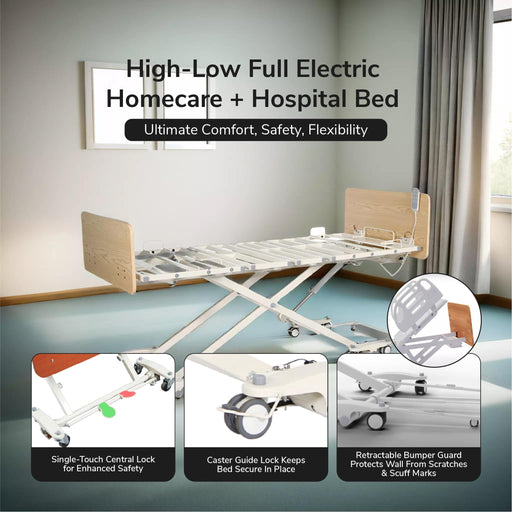
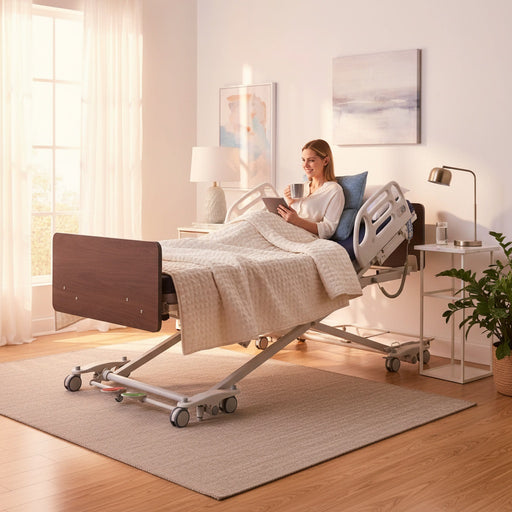
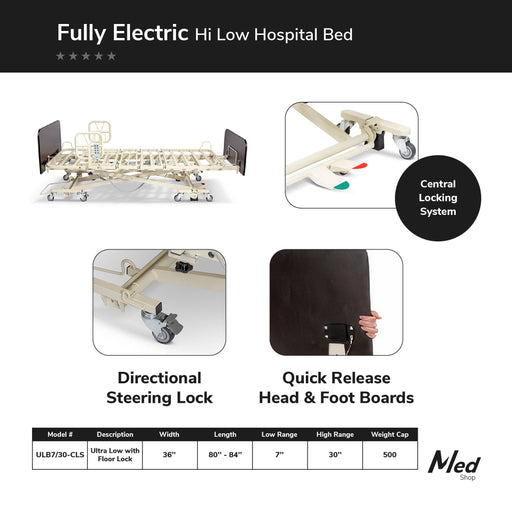
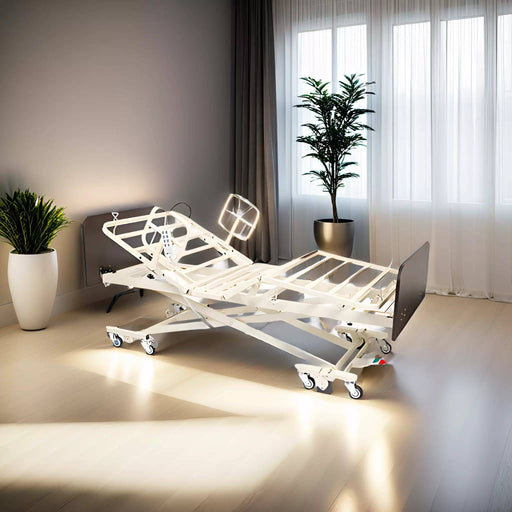


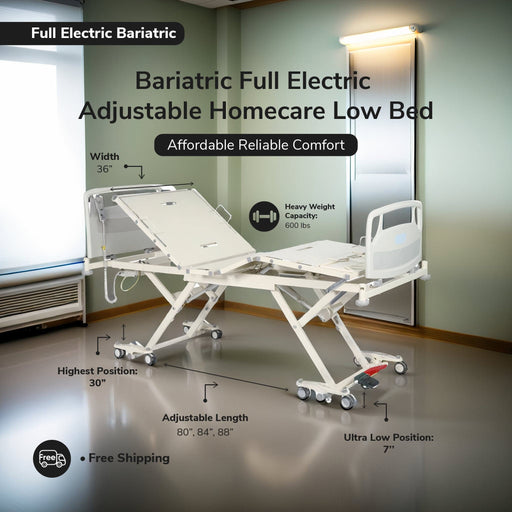
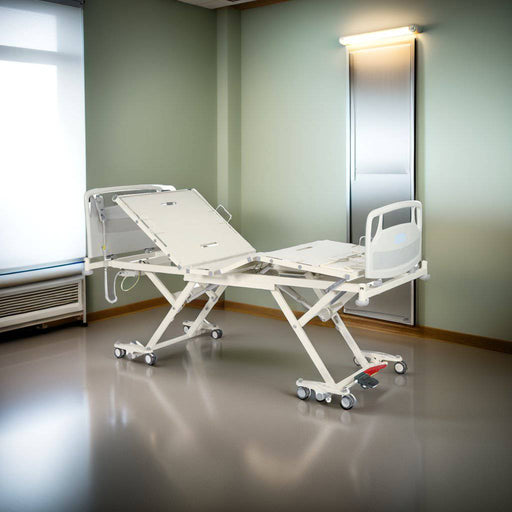
Leave a comment